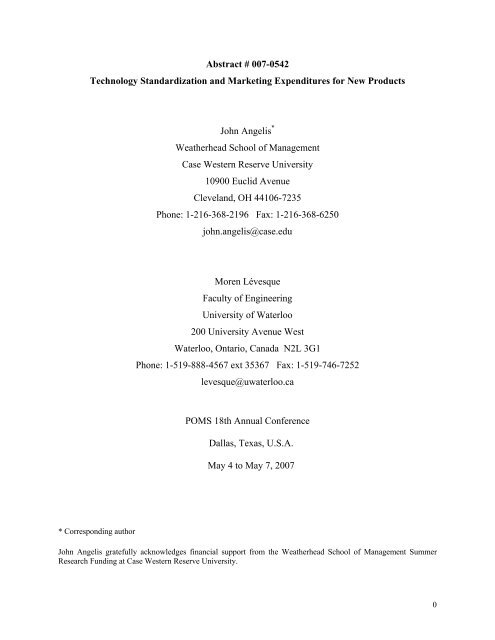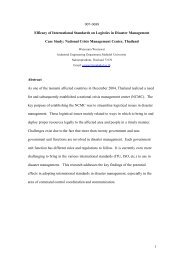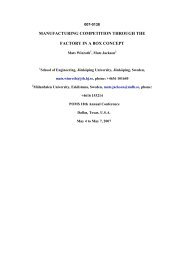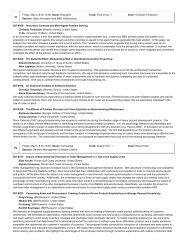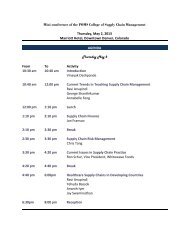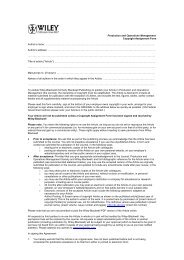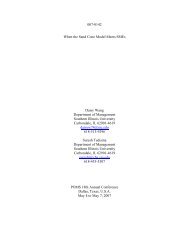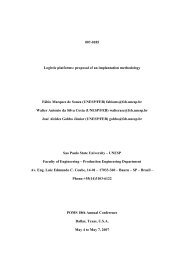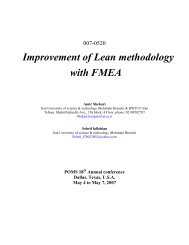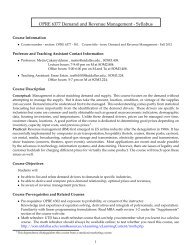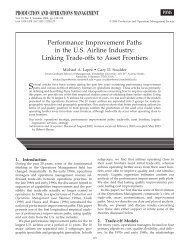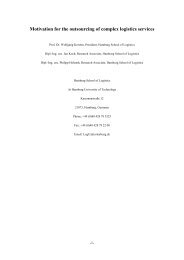Abstract # 007-0542 Technology Standardization and ... - POMS
Abstract # 007-0542 Technology Standardization and ... - POMS
Abstract # 007-0542 Technology Standardization and ... - POMS
Create successful ePaper yourself
Turn your PDF publications into a flip-book with our unique Google optimized e-Paper software.
<strong>Abstract</strong> # <strong>007</strong>-<strong>0542</strong><br />
<strong>Technology</strong> <strong>St<strong>and</strong>ardization</strong> <strong>and</strong> Marketing Expenditures for New Products<br />
John Angelis *<br />
Weatherhead School of Management<br />
Case Western Reserve University<br />
10900 Euclid Avenue<br />
Clevel<strong>and</strong>, OH 44106-7235<br />
Phone: 1-216-368-2196 Fax: 1-216-368-6250<br />
john.angelis@case.edu<br />
Moren Lévesque<br />
Faculty of Engineering<br />
University of Waterloo<br />
200 University Avenue West<br />
Waterloo, Ontario, Canada N2L 3G1<br />
Phone: 1-519-888-4567 ext 35367 Fax: 1-519-746-7252<br />
levesque@uwaterloo.ca<br />
<strong>POMS</strong> 18th Annual Conference<br />
Dallas, Texas, U.S.A.<br />
May 4 to May 7, 2<strong>007</strong><br />
* Corresponding author<br />
John Angelis gratefully acknowledges financial support from the Weatherhead School of Management Summer<br />
Research Funding at Case Western Reserve University.<br />
0
<strong>Technology</strong> <strong>St<strong>and</strong>ardization</strong> <strong>and</strong> Marketing Expenditures for New Products<br />
This paper focuses on a firm’s technology adoption decision, whereby the new technology affects<br />
the way in which customers interact with that firm’s product. We formulate a non-cooperative<br />
game-theoretic framework to investigate the conditions under which two competing firms should<br />
adopt the new technology, taking into account this adoption’s influence on marketing<br />
expenditures. We analyze how managers should select technologies based on the preferences of<br />
new or existing customers <strong>and</strong> demonstrate when a firm should select the new technology<br />
regardless of its rival’s technology choice. We show that technology st<strong>and</strong>ardization around the<br />
new technology may be a Nash equilibrium even if there is no coordination, <strong>and</strong> that coordination<br />
increases profits if the technology decision depends solely on the preferences of new customers.<br />
Overall, existing customers are a greater barrier to new technology adoption than new customers.<br />
Keywords: <strong>Technology</strong> Adoption, Marketing Expenditures, Game Theory<br />
1. Introduction<br />
The time lag between new versions of high-tech products has been steadily decreasing<br />
(Mahajan et al. 1993). In the personal computing industry, Hua <strong>and</strong> Wemmerlöv (2006) found<br />
that improving a product’s technology frequently to stay near the top in product advantage leads<br />
to increased sales <strong>and</strong> market share. Technologies such as enterprise resource planning (ERP)<br />
software <strong>and</strong> radio-frequency identification (RFID) chips are increasingly being implemented to<br />
increase sales <strong>and</strong> profits in both high- <strong>and</strong> low-tech products <strong>and</strong> services.<br />
The decision to adopt a new technology becomes even more important if the product<br />
itself is new, as making the right decision can increase market share <strong>and</strong> the speed at which the<br />
product diffuses to customers. A technology adoption success story is the wireless Internet<br />
industry. Major manufacturers had to decide what wi-fi technology st<strong>and</strong>ard would be used to<br />
transmit wireless Internet services (Goldstein 2004). As firms cooperated in choosing a st<strong>and</strong>ard,<br />
no firm had to be concerned with rivals gaining competitive advantages from choosing a<br />
different technology. This common st<strong>and</strong>ard also eliminated the risk to potential customers of<br />
buying from a firm with inferior wireless technology, <strong>and</strong> thus large firms such as Intel rapidly<br />
implemented wireless technology in their products.<br />
1
However, the wrong technology choice may doom the new product. In the nascent highresolution<br />
DVD industry, movie production firms <strong>and</strong> manufacturers are choosing between the<br />
Blu-Ray <strong>and</strong> HD-DVD formats. At this time, few high-resolution DVD discs <strong>and</strong> players have<br />
been purchased. If those who have yet to purchase prefer one format over the other, firms that<br />
chose the wrong one are likely to incur significant losses in sales, obsolete DVD inventory <strong>and</strong><br />
production equipment. Firms that chose the winning technology may realize larger profits than if<br />
they had cooperated in setting a common format; or they may be financially weakened by<br />
competition over format <strong>and</strong> unable to take advantage of their victory. A firm must thus consider<br />
carefully the risks <strong>and</strong> rewards associated with choosing the same technology as its rival.<br />
In this paper we examine the effects of technology adoption on new product sales. A<br />
well-chosen technology can add to a firm’s profits via sales by luring customers from rivals or by<br />
attracting new customers (i.e. those who are currently not purchasing) to the industry. The new<br />
technology may harm the firm if it causes new customers to become less likely to purchase, or<br />
existing customers who have finally understood the product balk at having to re-master it.<br />
Unlicensed restaurants now rely on Internet invitation systems in addition to traditional word-ofmouth<br />
methods. The adoption of this technology has attracted new customers, but has also driven<br />
away existing customers who preferred the unlicensed restaurants for their exclusivity (Karp<br />
2006). Because of examples like this <strong>and</strong> our focus on new products, we separate the customer<br />
pool into existing <strong>and</strong> new customers. Existing customers tend to be early adopters (Moore 2000)<br />
<strong>and</strong> new customers still require information on the firm <strong>and</strong> its product (Dorf <strong>and</strong> Byers 2005);<br />
the costs <strong>and</strong> benefits associated with each group of customers are by nature different.<br />
We thus ask: Given its impact on profits, sales, <strong>and</strong> marketing expenditures, <strong>and</strong> given<br />
the effect of a rival’s technology decision, when is a new technology profitable to adopt? We<br />
2
propose a two-stage framework in which a new technology is offered to two profit-maximizing<br />
firms selling a new product. We focus on individual sales rather than customers, as one customer<br />
may account for several sales. In the first stage, the firms are given the simultaneous opportunity<br />
to adopt the new technology. <strong>St<strong>and</strong>ardization</strong> occurs when both firms select the same technology<br />
(new or old), whereas diversification occurs when they select different ones. In the second stage,<br />
each firm chooses marketing expenditures targeted toward new customers <strong>and</strong> the existing<br />
customers of the other firm. The effectiveness of marketing expenditures (different for existing<br />
<strong>and</strong> new customers) may change if one or both firms adopt the new technology. Thus, second<br />
stage marketing decisions are influenced by first stage technology decisions.<br />
We contribute to the marketing literature by examining the sensitivity of marketing<br />
expenditures (<strong>and</strong> resulting sales <strong>and</strong> profits) with respect to technology adoption decisions <strong>and</strong><br />
changes in market conditions (e.g. sales retention). We observe that an increase in a firm’s<br />
existing sales may have a positive or negative effect on its <strong>and</strong> the rival’s profits. We also<br />
describe under what conditions the new technology should be adopted, <strong>and</strong> consider whether<br />
coordination between firms increase profits. §2 reviews the pertinent literature in marketing <strong>and</strong><br />
technology adoption, whereas §3 describes the decision model. The optimal marketing decision<br />
is highlighted in §4 <strong>and</strong> the equilibrium concept for the technology decision described in §5.<br />
Scenarios for optimal technology decisions are investigated in §6 <strong>and</strong> §7, while §8 offers some<br />
managerial implications <strong>and</strong> future work.<br />
2. Relevant Literature<br />
We first examine the literature on technology adoption <strong>and</strong> its limitations on modeling<br />
the effect of this adoption on sales. We subsequently examine the marketing literature that<br />
3
studies the effects of technology adoption on sales, <strong>and</strong> offer a rationale for modeling these<br />
effects separately on new <strong>and</strong> existing sales.<br />
2.1 <strong>Technology</strong> Adoption<br />
Several benefits exist for adopting new technologies. Gimenez (2006) argues that new<br />
technologies increase the quality of outputs or lower production costs. A new technology can<br />
also make a product “fashionable.” Peters (1992) argues that all firms need to be “fashionconscious”<br />
in developing new products. Also, positive novelty effects that ramp up existing sales<br />
may occur when a firm is the only one in the industry to adopt the new technology. Further, a<br />
new technology can make a product more valuable because it is easier for suppliers to create<br />
complements to accompany it. GE Fanuc Automation chose st<strong>and</strong>ard modular architectures for<br />
its industrial controllers, which allowed other component manufacturers to develop<br />
complementary products for the industrial controllers (Sanchez <strong>and</strong> Collins 2001).<br />
<strong>Technology</strong> games tend to stress coalition behavior <strong>and</strong> costs. Amaldoss <strong>and</strong> Rapaport<br />
(2005) offer a two-stage game in which firms cooperatively invest in their chosen network to<br />
develop products <strong>and</strong> then compete against other networks for customers. Axelrod et al. (1995)<br />
assumes that firms do not want to be in coalitions with rivals <strong>and</strong> that they prefer large alliances<br />
to small ones. Belleflamme (1998) allows for negative effects due to joining a coalition <strong>and</strong><br />
considers incomplete information games, whereas Gimenez (2006) examines the choice of<br />
investing in new technology by including learning costs. Van Wegberg (2004) studies how<br />
entrant <strong>and</strong> incumbent firms might play a game in choosing technology for new products.<br />
Instead, a key part of our model is exploring new technology adoption, especially<br />
st<strong>and</strong>ardization around the new technology. A full exposition of the advantages <strong>and</strong><br />
disadvantages of st<strong>and</strong>ardization versus diversification can be found in Besen <strong>and</strong> Farrell (1994).<br />
4
If the industry chooses a common technology for new products, it may lead to higher profits (van<br />
Wegberg 2004, Aldrich <strong>and</strong> Fiol 1994). However, it may be difficult to determine which<br />
technology should be chosen for st<strong>and</strong>ardization. Aldrich <strong>and</strong> Fiol (1994) argue that, for a<br />
nascent industry, not having product technology st<strong>and</strong>ardized lowers the perceived reliability or<br />
legitimacy of the product to outsiders. Typically, firms have a common technology – the<br />
empirical pattern is that industries converge to a dominant design (Anderson <strong>and</strong> Tushman,<br />
1990). Aldrich <strong>and</strong> Fiol (1994) add that firms with easy-to-imitate products have a greater<br />
incentive to cooperate on a technology st<strong>and</strong>ard.<br />
However, Katz <strong>and</strong> Shapiro (1985) show that it may not be beneficial for some firms if<br />
all firms st<strong>and</strong>ardize. Indeed, technology st<strong>and</strong>ardization may be unprofitable when firms are<br />
able to sustain high enough growth by themselves. Rice <strong>and</strong> Galvin (2006) noted that Nokia <strong>and</strong><br />
Ericsson’s lack of technology compatibility early on was partly because of high growth<br />
expectations at both firms. Neither firm thought common st<strong>and</strong>ardization was necessary for its<br />
new product to be successful. Therefore, both firms in our model may wish to have different<br />
technologies, <strong>and</strong> we contribute further to the literature by modeling this possibility. 1<br />
2.2 Customer Reactions to New <strong>Technology</strong><br />
The effects of new technology on sales have been underrepresented in previous literature,<br />
especially the consideration of separate effects on new <strong>and</strong> existing sales. Axelrod et al. (1995)<br />
mention in passing that technology affects market share, but do not explicitly model its effects on<br />
customers. Much of the work has been focused on industries where there are network<br />
externalities (a.k.a. positive dem<strong>and</strong> externalities); the product with the most users, or the<br />
technology being used by the most firms, is the most valuable. Thus, the focus has been on<br />
1 We further note that the technology-search literature (e.g. Lippman <strong>and</strong> McCardle 1991, 1987), which models over<br />
time searching for a new technology of uncertain value, do not model marketing effects <strong>and</strong>/or firm competition.<br />
5
product compatibility, whereby if a product does not have enough sales, the firm has greater<br />
incentive to make that product compatible to other firms’ product (Katz <strong>and</strong> Shapiro 1985).<br />
However, Katz <strong>and</strong> Shapiro (1985) also demonstrate that this compatibility may lower<br />
other firms’ profits. Farrell <strong>and</strong> Saloner (1986) study this from a time of adoption perspective<br />
<strong>and</strong> point out that older customers have less surplus value from their purchase than newer<br />
customers who purchase when there are more users of the product. Finally, Farrell <strong>and</strong> Saloner<br />
(1988) <strong>and</strong> van Wegberg (2004) study mechanisms by which firms could st<strong>and</strong>ardize new<br />
technologies, such as an individual firm taking the lead <strong>and</strong> setting a technology st<strong>and</strong>ard, or<br />
cooperative st<strong>and</strong>ard-setting among all firms. Because we assume that the product itself is new,<br />
we contribute by segmenting sales into existing <strong>and</strong> new. We also contribute by examining<br />
customer rather than firm preferences for technology, whereby customer preferences may result<br />
in positive externalities for one firm but negative externalities for another.<br />
2.3 Marketing Efforts<br />
We choose to model marketing to new <strong>and</strong> existing customers separately, because the<br />
attitudes of these two groups towards a change in technology is likely to be different. Farrell <strong>and</strong><br />
Saloner (1986) provide insight into the phenomenon of balancing new <strong>and</strong> existing users by<br />
focusing on products where the new technology is incompatible with the old product. They also<br />
model whether the firm adopts the new technology expecting new customers to be the primary<br />
source of sales, or expecting old customers to switch from the product with the old technology.<br />
However, they neither model the case where the new technology is preferred by existing<br />
customers nor do they focus on the marketing aspects of the decision.<br />
There are research in marketing that do separate the effectiveness of marketing<br />
expenditures of each firm depending on whether the sale being targeted is new or existing,<br />
6
including Angelis <strong>and</strong> Lévesque (2006), Bass et al. (2005), <strong>and</strong> Wrather <strong>and</strong> Yu (1979). We add<br />
insights by considering technology adoption decisions <strong>and</strong> how these decisions may<br />
simultaneously change the marketing effectiveness on both new <strong>and</strong> existing customers.<br />
3. Model Formulation<br />
3.1 Decision Variables<br />
In the first stage, each firm (firm i, firm j) decides whether to retain the old technology or<br />
switch to the new one. The technology choice is modeled by binary decision variables ϕ ∈ { 0,1}<br />
<strong>and</strong> ϕ ∈ { 0,1}<br />
j<br />
, respectively, where 0 is the choice to retain the old technology <strong>and</strong> 1 the choice<br />
to switch to the new technology. The unit profit margin is denoted by<br />
πi<br />
for firm i <strong>and</strong> π<br />
j<br />
for<br />
firm j. Because of our desire to concentrate on the effects of technology adoption on marketing,<br />
we assume that there is no effect on unit profit margin due to new technology adoption.<br />
In the second stage – i.e. after the technology adoption decisions – firms choose their<br />
marketing expenditures. Firms are assumed to have a different effectiveness (i.e. return on<br />
expenditures) for existing <strong>and</strong> new sales. Thus, firms have different expenditures aimed at each<br />
type of sale, as in Angelis <strong>and</strong> Lévesque (2006), Bass et al. (2005), <strong>and</strong> Wrather <strong>and</strong> Yu (1979).<br />
Expenditures used to acquire existing sales of the other firm are labeled share expenditures,<br />
whereas those used to attract new sales are labeled growth expenditures. Firms i <strong>and</strong> j select<br />
i<br />
share expenditures<br />
ai<br />
<strong>and</strong><br />
a<br />
j<br />
, <strong>and</strong> growth expenditures<br />
gi<br />
<strong>and</strong><br />
g<br />
j<br />
, respectively, in order to<br />
maximize total profits. Table 1 summarizes notation for firm i; decision variables, functions <strong>and</strong><br />
parameters are denoted the same for firm j with the appropriate change in subscript.<br />
----------------- Insert Table 1 about here -----------------<br />
7
3.2 Profits <strong>and</strong> Sales Functions<br />
We focus on firm i’s profits <strong>and</strong> sales function because those for firm j can<br />
straightforwardly be derived by symmetry. Firm i’s existing sales are denoted<br />
S i,0<br />
; those existing<br />
sales are totaled at the beginning of the first stage, before the technology decision is made. After<br />
the technology <strong>and</strong> marketing decisions are made, total sales at the end of the second stage result<br />
at a value of S – we subsequently introduce the sales function . Firm i’s profit is π S <strong>and</strong> its<br />
i<br />
Si<br />
i i<br />
objective is to maximize that profit net of marketing expenditures,<br />
P i<br />
, that is,<br />
Max<br />
P = Max π S −a<br />
with . (1)<br />
i i i i<br />
− g i<br />
a , g , S ≥ 0<br />
ϕi∈{0,1}, ai, gi ϕi∈{0,1}, ai,<br />
gi<br />
i i i<br />
The model partitions all potential industry sales into three segments:<br />
<strong>and</strong><br />
S<br />
i,0<br />
S<br />
j,0<br />
, which<br />
are the existing sales for each firm, <strong>and</strong> new potential sales that do not belong to either firm. We<br />
assume a market (industry) ceiling as in Fruchter (1999) <strong>and</strong> Erickson (2003) <strong>and</strong> denote that<br />
m<br />
0 ,0<br />
ceiling as<br />
0<br />
. Thus, new sales account to m −Si<br />
− S j,0<br />
. We follow the example of Erickson’s<br />
(2003) diffusion model <strong>and</strong> identify the external <strong>and</strong> internal influences which direct new sales to<br />
a firm. The external influence is the firm’s own growth expenditures, while the internal influence<br />
is positive word-of-mouth between the firm’s existing customers <strong>and</strong> new customers.<br />
We first introduce the external influence term. Firms i <strong>and</strong> j allocate growth expenditures<br />
toward attracting new sales that have an impact of, respectively,<br />
g μ<br />
1 − i<br />
i<br />
<strong>and</strong><br />
1 − j<br />
j<br />
g μ<br />
. Exponent terms<br />
μ ∈ (0,1) <strong>and</strong> μ ∈(0,1)<br />
i<br />
j<br />
highlight the decreasing-returns nature of growth expenditures.<br />
Further, the effectiveness of growth expenditures represents the percentage of new sales a firm<br />
realizes based on these expenditures, due to its marketing ability <strong>and</strong> the receptiveness of new<br />
sales to that ability. This effectiveness depends on the technology chosen by each firm <strong>and</strong> is<br />
thus denoted by β ( ϕ , ϕ ) ∈ ( 0,1) for firm i <strong>and</strong> β ( ϕ , ϕ ) ∈(<br />
0,1)<br />
for firm j. Specifically, firm<br />
i i j<br />
j i j<br />
8
i’s growth expenditure effectiveness is β<br />
i<br />
(0,0) when both firms remain with the old technology,<br />
β<br />
i<br />
(1, 0) if only firm i chooses the new technology, β<br />
i<br />
(0,1) if only firm j chooses the new<br />
technology, <strong>and</strong> β<br />
i<br />
(1,1) if both firms switch to the new technology.<br />
As for the internal influence, new sales may also enter firm i via word-of-mouth effects<br />
between its existing <strong>and</strong> new customers. Word-of-mouth effects are accentuated by existing sales<br />
<strong>and</strong> thus represented by ε iS i, 0<br />
. In turn, word-of-mouth effects (not affected by the expenditures<br />
of either firm) are applied toward new sales to yield a total effect of<br />
ε S [ m −S −S<br />
]. In<br />
i i,0 0 i,0 j,0<br />
other words, the product of Si,0<br />
<strong>and</strong> m0 −Si,0<br />
− S j,0<br />
represents the maximum sales interaction<br />
possible: each existing sale of firm i interacts with each new sale. That maximum interaction is<br />
weighed by<br />
ε i<br />
. We next introduce the terms of the sales function that account for share (as<br />
opposed to growth) expenditures.<br />
Firms i <strong>and</strong> j allocate share expenditures toward attracting new sales that have an impact<br />
) λ ∈ )<br />
1<br />
of, respectively, − 1<br />
i<br />
j<br />
<strong>and</strong> a − λ<br />
( λ ∈ (0,1 <strong>and</strong> (0,1 highlight the decreasing-returns nature<br />
a λ<br />
i<br />
j<br />
i<br />
of these expenditures). Effectiveness of these expenditures represents the percentage of a rival’s<br />
existing sales a firm is able to attract based on its own share expenditures, due to its marketing<br />
ability <strong>and</strong> the receptiveness of the rival’s existing sales to that ability. For firm j, this<br />
j<br />
effectiveness depends on the technology chosen <strong>and</strong> is denoted by<br />
(<br />
ρ ( ϕϕ ) ∈ 0,1<br />
j i j<br />
)<br />
; similarly<br />
ρ ( ϕ , ϕ ) ∈ 0,1<br />
i i j<br />
(<br />
)<br />
for firm i. The dependence of share expenditure effectiveness on technology<br />
choice is similar to that of growth expenditure effectiveness.<br />
In addition to the sales lost to firm j, we model the change in existing sales of firm i due<br />
to sales departing the industry altogether. Existing customers decide not to purchase from the<br />
industry again due to non-expenditure factors such as forgetfulness or product <strong>and</strong> market<br />
9
characteristics. The ordering of events is that first, existing customers decide whether to remain<br />
with their firm or leave the industry, <strong>and</strong> then, firms invest in share expenditures to acquire the<br />
retained sales of the other firm. Let<br />
δ ∈[0,1]<br />
i<br />
measure the percentage of existing sales that are<br />
retained by firm i, <strong>and</strong> [ 1 −δ i<br />
] the percentage that depart. Firm i targets the retained existing sales<br />
of firm j, i.e. δ<br />
jS<br />
j,0<br />
rather than S<br />
j,0<br />
.<br />
Consequently, firm i’s sales function can be expressed as<br />
{ }{ }<br />
S ⎡<br />
a ⎤<br />
⎣<br />
⎦<br />
S a S g S m S<br />
1−λ 1 1<br />
1 ( , ) j −λ ,0<br />
( , ) i −μ<br />
i<br />
= − ρj ϕi ϕj j<br />
δi i<br />
+ ρi ϕi ϕj i<br />
δ<br />
j j,0 + βi( ϕi, ϕj)<br />
i i + εi i,0 0<br />
−<br />
i,0 −<br />
j,0<br />
S . (2)<br />
The first term is firm i’s addition of its existing sales due to sales retention <strong>and</strong> its loss of existing<br />
sales to the share expenditures of its rival, firm j. The second term is firm i’s addition of the<br />
rival’s existing sales via share expenditures. The third term measures firm i’s addition of new<br />
sales through growth expenditures <strong>and</strong> its addition of new sales due to word-of-mouth effects.<br />
4. Second Stage Solution <strong>and</strong> Sensitivity of Firm Performance<br />
We proceed to solve the two-stage game using the commonly used rollback technique<br />
(Dixit <strong>and</strong> Skeath 1999). We begin by solving the game at the second stage for optimal share <strong>and</strong><br />
growth expenditures. Details appear in the appendix. We then calculate the relationship between<br />
these expenditures, <strong>and</strong> conduct sensitivity analysis on the resulting profits <strong>and</strong> sales to further<br />
investigate the effectiveness of a variety of strategies to improve firm performance. The results<br />
of our sensitivity analysis are summarized in Table 2, with key results formally described in<br />
Propositions 1 to 3. The results in Proposition 1 are straightforwardly obtained from taking the<br />
partial derivatives of optimal share <strong>and</strong> growth expenditures (i.e. the right-h<strong>and</strong> side of equations<br />
3 <strong>and</strong> 4 below) with respect to each parameter, holding all other parameters constant. For<br />
Propositions 2 <strong>and</strong> 3, optimal expenditures are substituted into sales <strong>and</strong> profits functions. Partial<br />
10
derivatives of these functions are then taken with respect to each parameter. Hence, our further<br />
analysis refers to what actions should be taken when optimal expenditures are implemented.<br />
----------------- Insert Table 2 about here -----------------<br />
4.1 Optimal Marketing Expenditures<br />
Optimal share <strong>and</strong> growth expenditures for firm i are, respectively,<br />
*<br />
a i<br />
= πρ i i<br />
( ϕ i<br />
, ϕ j<br />
)[1 −λ i<br />
] δS j j ,0<br />
1/ λi<br />
⎡<br />
⎣<br />
⎤<br />
⎦ (3)<br />
<strong>and</strong><br />
g = ⎣ ⎡π [1 −μ ] β ( ϕ , ϕ )[ m −S −S<br />
*<br />
i i i i i j 0 i,0 j,0<br />
1/ μi<br />
⎤<br />
⎦ . (4)<br />
We examine equations (3) <strong>and</strong> (4) assuming interior solutions. 2<br />
Optimal growth <strong>and</strong> share<br />
expenditures are likely to change when a key model parameter is increased or decreased. We first<br />
highlight from Table 2 the effects of environmental changes on a firm’s marketing expenditures.<br />
An increase in a firm’s unit profit margin should increase both share <strong>and</strong> growth expenditures,<br />
because the firm obtains a higher return on each dollar spent in marketing. On the other h<strong>and</strong>, an<br />
increase in its existing sales should decrease growth expenditures, as there are now fewer sales<br />
for that firm to attract than before. Also, if the firm notices an increase in its effectiveness in<br />
share or growth expenditures, it should increase the affected expenditure. The rationale is that<br />
each dollar invested in that expenditure has a higher return in terms of sales than before the<br />
2 Given the sales function in (2), total sales at the end of the second stage for a firm must be positive <strong>and</strong> not exceed<br />
the market ceiling; i.e., Si<br />
∈ (0, m0<br />
) , Sj<br />
∈ (0, m0<br />
) , <strong>and</strong> Si<br />
+ Sj<br />
< m0<br />
. Thus, share <strong>and</strong> growth expenditures should be<br />
bounded so that a firm cannot acquire more than 100% of its rival’s existing sales <strong>and</strong> no new sale is attracted twice.<br />
If none of the constraints are violated, optimal expenditures are as in (3) <strong>and</strong> (4) <strong>and</strong> obtained by using the first-order<br />
derivative of the objective function with respect to expenditures. If any one of the above constraint does not hold,<br />
1/ [ 1−λi<br />
]<br />
1−<br />
1/ [ 1 i ]<br />
j<br />
⎡<br />
* 1 ⎤<br />
1 g μ −μ<br />
⎡ −<br />
* j<br />
β<br />
j( ϕi, ϕj)<br />
−εiSi,0 −ε<br />
jS<br />
⎤<br />
j,0<br />
ai<br />
≤ ⎢ ⎥ or gi<br />
≤ ⎢<br />
⎥ , (*)<br />
⎢⎣ρi( ϕi, ϕj)<br />
⎥⎦<br />
⎢⎣<br />
βi( ϕi, ϕj)<br />
⎥⎦<br />
depending on which constraint(s) is (are) violated. However, note that implementations of (*) mean that the new<br />
product competition is over, as either S<br />
j<br />
= 0 or Si<br />
+ Sj<br />
= m0<br />
, respectively. Thus, we focus on the unconstrained<br />
solutions of the expenditure variables for subsequent analysis.<br />
11
increase. Because sales retention <strong>and</strong> word-of-mouth effects are independent of the firm’s<br />
expenditures, a change in either should not change expenditures. In addition, the market ceiling,<br />
an environmental feature that is the same for both firms, also has an expected effect on growth<br />
expenditures: the more the sales in the market, the more money both firms should spend.<br />
The changes just described on a firm’s marketing expenditures are intuitive. More<br />
challenging are the changes in the environment of a rival that force the firm to change its<br />
marketing expenditures. Table 2 shows that a firm should react to increases in a rival’s sales<br />
retention or existing sales by increasing its investment in acquiring the sales of that rival. It may<br />
not be necessary, however, for the firm to increase its total marketing expenditures. Formally,<br />
Proposition 1: A firm’s total marketing expenditures is expected to increase when<br />
(a) sales retention increases for its rival (i.e. δ<br />
j<br />
is increased); or<br />
(b) existing sales increase for its rival (i.e. S<br />
j,0<br />
is increased) if <strong>and</strong> only if the ratio of<br />
share to growth expenditures (i.e.<br />
a<br />
/ g ) exceeds a threshold.<br />
* *<br />
i i<br />
Proposition 1(a) recommends an increase in total marketing expenditures when a firm’s<br />
rival increases its sales retention (<strong>and</strong> thus increases its existing sales). In particular, as seen in<br />
Table 2, the firm should increase its investment in share expenditures to match the opportunity<br />
for increased acquisition of the rival’s sales. The firm should not change its investment in growth<br />
expenditures, since the total number of new sales has not changed (we assumed that when<br />
existing sales depart a firm, they exit the market as a whole).<br />
In contrast, Proposition 1(b) suggests that a firm be cautious with respect to increasing<br />
total marketing expenditures in response to an increase in the existing sales of its rival. The<br />
direction of change from Table 2 shows an increase for share expenditures but a decrease for<br />
growth expenditures. To evaluate whether or not the benefits from an increase in share<br />
12
expenditures exceeds the losses from a decrease in growth expenditures, the firm should examine<br />
the sales ratio<br />
λiS<br />
j,0<br />
. This ratio provides the firm with a benchmark of how its<br />
[ m S S ]<br />
i<br />
0 i,0 ,0<br />
μ − − j<br />
investments in share <strong>and</strong> growth expenditures compare with the actual opportunity – that is,<br />
existing sales of its rival, new sales, <strong>and</strong> the diminishing returns from both types of sales.<br />
For instance, suppose the product of (diminishing) returns on share expenditures <strong>and</strong> its<br />
rival’s existing sales ( λiS<br />
j,0<br />
) is twice as large as the product of returns on growth expenditures<br />
]<br />
<strong>and</strong> new sales ( μ [ m −S − S ). If the firm is spending over twice as much on share<br />
i<br />
0 i,0 j,0<br />
expenditures than on growth expenditures, then total marketing expenditures should increase.<br />
Hence, before a firm concludes that its rival’s increase in existing sales means that the firm must<br />
obtain additional funds with which to target those sales, it should also consider its growth<br />
expenditures, diminishing returns on share <strong>and</strong> growth expenditures, <strong>and</strong> the size of its two sales<br />
sources (new customers <strong>and</strong> its rival’s existing customers). The firm may be able to pay for the<br />
increased share expenditures by decreasing growth expenditures <strong>and</strong> still save money.<br />
4.2 Sensitivity of Firm Performance<br />
Firm performances are affected by environmental changes. As far as its own environment<br />
is concerned, increases in unit profit margin, effectiveness of share or growth expenditures, sales<br />
retention, word-of-mouth effect, or market ceiling all increase a firm’s sales <strong>and</strong> profits, as<br />
expected <strong>and</strong> summarized in Table 2. As far as the environment of its rival is concerned, if that<br />
rival experiences an increase in unit profit margin or effectiveness of share expenditures, then the<br />
firm’s performance should decrease. The rival should use some of its increase to augment share<br />
13
expenditures, which results in the firm losing sales (<strong>and</strong> profits). 3<br />
On the other h<strong>and</strong>,<br />
conventional strategy based on first mover advantages (Lieberman <strong>and</strong> Montgomery 1988) <strong>and</strong><br />
economies of scale (Frank 2000) seems to indicate that a firm would prefer its own sales to be as<br />
large as possible <strong>and</strong> the sales of its rival as small as possible. We suggest that a firm exhibits<br />
higher returns on its share expenditures if its rival exhibits higher existing sales. Formally,<br />
Proposition 2:<br />
(a) An increase in a firm’s existing sales (i.e.<br />
S i,0<br />
is increased) does not necessarily lead<br />
to increased sales or profits for that firm.<br />
(b) An increase in the existing sales of that firm’s rival (i.e. S<br />
j,0<br />
is increased) does not<br />
necessarily lead to decreased sales or profits for that firm. 4<br />
For part (a), an increase in its existing sales may yield lower performance because these<br />
existing sales lessen the profits from its growth expenditures (there are less new sales) <strong>and</strong><br />
increase the share expenditures of its rival. An increase in a firm’s existing sales does not<br />
increase its return on marketing expenditures, but improves the number of sales that the firm can<br />
retain <strong>and</strong> the word-of-mouth effect of its existing sales on new sales. Hence, the condition<br />
underlying part (a) is a threshold. If profits <strong>and</strong> sales not due to marketing expenditures exceed<br />
that due to marketing expenditures, then the firm improves its performance when its existing<br />
sales increase. 5 Thus, if a firm’s existing sales are higher than it can sufficiently retain (whether<br />
3 But a firm’s performance should not be altered by a change in the growth expenditure effectiveness of its rival or<br />
word-of-mouth effect (both of which influencing how many new sales the rival can conquer). This holds because its<br />
rival’s increase does not decrease the firm’s attraction of new sales; there are enough new sales to go around.<br />
4 Equivalently, (a) a decrease in a firm’s existing sales (i.e. S i,0<br />
is decreased) does not necessarily lead to decreased<br />
sales or profits for that firm or (b) a decrease in the existing sales of that firm’s rival (i.e. S j,0<br />
is decreased) does not<br />
necessarily lead to increased sales or profits for that firm.<br />
5 I.e., the firm improves its profits when its existing sales increase if <strong>and</strong> only if (the condition is similar for sales)<br />
1−λ<br />
j<br />
1−μi<br />
⎡ λ j<br />
π<br />
1<br />
,0 { [ }<br />
1<br />
0 ,0 ,0]<br />
i<br />
jS ⎤<br />
i π<br />
i<br />
m −Si −S<br />
μ<br />
j<br />
0<br />
2<br />
,0 ,0<br />
[1 ] j<br />
[ ] i<br />
i<br />
+ ⎡<br />
i<br />
m Si S<br />
⎣ ⎦<br />
λ<br />
j j j i<br />
[1<br />
i] μ<br />
⎣ − − ⎤<br />
⎦ > ⎡ ⎤<br />
i<br />
λ ⎣ − ⎦ + −<br />
j<br />
μi<br />
δ ε ρ λ δ μ β<br />
.<br />
14
that means the sales are departing to a rival or the industry) or are lowering the firm’s ability to<br />
attract new sales, increasing existing sales may lower that firm’s profitability. The firm should<br />
not aim at maximizing sales without first guaranteeing that it can successfully retain those sales.<br />
For part (b), recall from Proposition 1 that increased existing sales for the rival may yield<br />
increased or decreased optimal marketing expenditures for the firm. The rationale for Proposition<br />
2(b) is similar to that of Proposition 1(b). 6 The more existing sales a firm acquires from share<br />
expenditures as opposed to new sales from growth expenditures or word-of-mouth, the more<br />
likely it is to increase profits from an increase in the rival’s existing sales. On the other h<strong>and</strong>, if a<br />
firm is concentrating on growing via new sales, any increase in its rival’s existing sales decreases<br />
the number of new sales available <strong>and</strong> lowers the firm’s return on growth expenditures. 7<br />
Implications follow from the application of Propositions 2. When a decrease in its own –<br />
or an increase in its rival’s – existing sales increases a firm’s profits, that firm has a counterintuitive<br />
incentive to possess as few existing sales as possible relative to its rival. If its rival is<br />
experiencing rapid sales growth, such a firm should focus on improving the effectiveness of its<br />
share expenditures so as to increase acquisition of rival sales. This may portray a firm that is<br />
better suited to follow its rival rather than being a first mover, as with Microsoft <strong>and</strong> the Internet<br />
browser market. Netscape did much of the early selling of Internet browsers, <strong>and</strong> Microsoft then<br />
aggressively acquired much of that market share once there was significant dem<strong>and</strong>. When an<br />
increase in its own – or a decrease in its rival’s – existing sales increases a firm’s profits, that<br />
6 That is, an increase in the existing sales of the firm’s rival increases that firm’s profits if <strong>and</strong> only if<br />
1−μ<br />
1−λ<br />
i<br />
i<br />
μi<br />
λi<br />
1<br />
iS j,0 { [ }<br />
1<br />
⎦<br />
π<br />
i<br />
m0 Si,0 Sj,0]<br />
ρ[1 ] i<br />
[[1 ] ] i<br />
i<br />
λi δ<br />
λ<br />
j<br />
μ μ<br />
i<br />
βi πiεiSi,0<br />
λ ⎣<br />
⎡ − ⎦<br />
⎤ > − +<br />
i<br />
μi<br />
⎡π<br />
⎤<br />
⎣<br />
− −<br />
7 It can be further broken down by the terms in (3) <strong>and</strong> (4); a firm is more likely to increase profits from the rival’s<br />
increase in existing sales if it has high effectiveness of share expenditures or its rival has high sales retention. An<br />
increase in market ceiling, existing sales, effectiveness of growth expenditures, or word of mouth makes it more<br />
likely that a firm decreases profits from the rival’s increase in existing sales.<br />
.<br />
15
firm’s new product can survive by itself as sales <strong>and</strong> profits are increased. In addition, driving its<br />
rival to zero sales would not hurt the firm. The firm should thus focus on increasing existing<br />
sales retention <strong>and</strong> rewarding existing customers for bringing in new business rather than<br />
investing in improving the effectiveness of share <strong>and</strong> growth expenditures.<br />
We further note that an increase in the market ceiling is profitable to both firms (more<br />
available sales for the new product equals more profits), but less expected is the observation that<br />
an increase in sales retention for the rival is also profitable to both firms. If the rival can retain<br />
sales, the firm is able to compete for the business of those sales <strong>and</strong> improve its performance.<br />
But if the rival cannot retain its existing sales, both firms suffer decreased profits. Formally,<br />
Proposition 3: If the sales retention of the firm’s rival increases (i.e. δ<br />
j<br />
is increased), then<br />
that firm’s sales <strong>and</strong> profits increase.<br />
We next solve the game in the first stage for the technology adoption decision, utilizing<br />
optimal expenditure amounts calculated from this second stage. From the first stage, we examine<br />
how profits change when both firms simultaneously change their growth or share expenditure<br />
effectiveness due to technology adoption. The rollback technique used herein guarantees that the<br />
technology adoption decision is optimal for the second as well as the first stage.<br />
5. First Stage Solution: Equilibrium Concept<br />
Both firms simultaneously decide whether or not to adopt the new technology. Four<br />
possible technology sets exist, representing the two possible technology choices for each firm.<br />
For instance, when firm i does not adopt the new technology but firm j does, the technology set<br />
is {0,1}, <strong>and</strong> P (0,1) <strong>and</strong> (0,1) denote the profits of firm i <strong>and</strong> firm j, respectively. Assuming<br />
i<br />
P j<br />
that each firm has implemented optimal marketing expenditures from the second stage, in the<br />
16
first stage firm i selects whether to retain the old technology (i.e. ϕ = 0) or adopt the new<br />
technology (i.e. ϕ<br />
i<br />
= 1) so as to maximize its profit. That is,<br />
i<br />
ϕi∈(0,1)<br />
⎡<br />
⎢δ λ π λ ⎣ρ ϕ ϕ δ<br />
⎢<br />
1−λi<br />
1<br />
λi<br />
,0<br />
[ [1 ]] ( , )<br />
i<br />
iSi +<br />
i i<br />
− ⎡<br />
i i i j jS<br />
⎤λ<br />
j,0<br />
1−λ<br />
j<br />
⎢<br />
1<br />
λ j<br />
j<br />
i<br />
ϕi ϕj = πi j j j i j iS<br />
λ<br />
⎢− − λ π ⎡ρ ϕ ϕ δ ⎤<br />
i,0 + εiS ⎡<br />
i,0 m0 −Si,0 −Sj,0<br />
Max P( , ) Max [[1 ] ] ⎣ ( , ) ⎦ ⎣<br />
⎢<br />
⎢<br />
⎢+ μ π −μ ⎣β ϕ ϕ − − ⎦<br />
⎢⎣<br />
1−μi<br />
1<br />
μi<br />
[ [1 ]] ⎡ ( , )[<br />
0 ,0 ,0]<br />
i<br />
i i i i i j<br />
m Si S ⎤μ<br />
j<br />
⎦<br />
⎤<br />
⎥<br />
⎥<br />
⎥<br />
⎤<br />
⎦⎥. (5)<br />
⎥⎥⎥⎥<br />
⎦<br />
Although each firm attempts to maximize its profits, an increase in a firm’s profits does not<br />
necessarily lead to a decrease in its rival’s profits. Consequently, this is a non-zero sum game.<br />
A strategy describes which technology a firm should select given what it knows about the<br />
effect of each technology on its <strong>and</strong> the rival’s profits. The firm’s strategy may be to r<strong>and</strong>omly<br />
select a technology, select a technology conditionally based on the technology the rival might<br />
select, or to always select a particular technology. Formally, the three types of strategies are<br />
mixed strategy: the firm cannot determine with certainty which technology choice it should<br />
select, which may happen even if the firm knew its rival’s technology choice;<br />
pure strategy: the firm can determine with certainty which technology choice is more<br />
profitable, if it knew its rival’s technology choice; or<br />
dominant strategy: the firm can determine with certainty which technology choice is more<br />
profitable, regardless of its rival’s technology choice.<br />
If a firm possesses two pure strategies, both recommending the same technology, then that<br />
technology dominates regardless of the rival’s choice. If it possesses two pure strategies, both<br />
recommending different technologies, <strong>and</strong> cannot anticipate the rival’s choice, then that firm’s<br />
strategy is mixed. Also, a firm may have a pure strategy for one of the rival’s choice <strong>and</strong> a mixed<br />
strategy for the other choice.<br />
17
For our solution concept we use Nash equilibrium. Specifically, after both firms make<br />
their decision, each is informed of the other’s decision. A firm regrets its decision if, given its<br />
rival’s decision, that firm would have increased profits by selecting the other technology. If, for a<br />
given technology set, neither firm increases profits by switching to the other technology while<br />
the other firm does not switch, then that set is a Nash equilibrium. A Nash equilibrium set is<br />
regret-proof, i.e. neither firm regrets its decision after learning what the other firm has chosen.<br />
We confine our analysis to scenarios where there is at least one pure strategy Nash equilibrium. 8<br />
The game starts with both firms using the old technology. If coordination is forbidden,<br />
the potential outcomes of the game are determined with certainty under the following conditions.<br />
st<strong>and</strong>ardization around the old technology: the technology set {0,0} is regret-proof;<br />
technology diversification, firm i retains the old technology: the technology set {0,1} is<br />
regret-proof but {1,0} is not;<br />
technology diversification, firm i adopts the new technology: the technology set {1,0} is<br />
regret-proof but {0,1} is not;<br />
st<strong>and</strong>ardization around the new technology: the technology set {0,0} is not regret-proof but<br />
{1,1} is.<br />
Mathematical expressions for the sufficient conditions under which each outcome occurs with<br />
certainty (a pure strategy Nash equilibrium) are presented in Table 3. Table 3 shows that since<br />
{0,0} is the starting point of the game, {0,0} is the outcome when regret-proof even if there is<br />
another pure strategy Nash equilibrium (i.e. {1,1}). For the other technology sets to be the<br />
outcome, at least one firm must have a dominant strategy.<br />
----------------- Insert Table 3 about here -----------------<br />
8 Pure as opposed to mixed strategy Nash equilibrium in which one or both firms r<strong>and</strong>omly select a technology<br />
because neither technology choice is optimal, given the technology choice(s) of the other firm.<br />
18
6. <strong>Technology</strong> Decision <strong>and</strong> New Sales Attraction<br />
We first illustrate how the firm’s technology adoption decision affects profits via a<br />
change in growth expenditure effectiveness, <strong>and</strong> then offer guidance as to the profit-maximizing<br />
technology decision. If, on average, new customers perceive the product as being more attractive<br />
after a technology change, then growth expenditure effectiveness increases. According to Table<br />
2, this increase augments a firm’s growth expenditures, sales <strong>and</strong> profits, but has no effect on the<br />
rival’s profits. The firm’s technology adoption decision thus only depends on the direction of the<br />
change in its own growth expenditure. Formally, P( ϕ , ϕ ) > P( ϕ′ , ϕ′<br />
) if <strong>and</strong> only if<br />
i i j i i j<br />
β ( ϕ , ϕ ) > β ( ϕ′ , ϕ′<br />
), where the technology sets ϕ , } <strong>and</strong> { ϕ′ , ϕ′ } are different. Selecting<br />
i i j i i j<br />
{<br />
i<br />
ϕ<br />
j<br />
the first-stage technology that leads to larger growth expenditure effectiveness allows the firm to<br />
experience higher returns from second-stage growth expenditures.<br />
There are 24 distinct orderings for β ϕ , ϕ ) ; e.g. β (1,0) > β (1,1) > β (0,0) > β (0,1) .<br />
i<br />
(<br />
i j<br />
i<br />
j<br />
i i i i<br />
We refer to the largest β ϕ , ϕ ) as the maximum growth expenditure effectiveness (i.e.<br />
i<br />
(<br />
i j<br />
acquiring the maximum number of new customers) <strong>and</strong> the smallest β ϕ , ϕ ) as the minimum<br />
i<br />
(<br />
i j<br />
growth expenditure effectiveness. To limit duplication, we focus on orderings where adopting the<br />
new technology yields maximum effectiveness. We report on optimal strategies based on a<br />
firm’s ordering, assumed known by that firm, <strong>and</strong> consider the role of coordination in decisionmaking.<br />
We examine orderings that lead to dominant strategies. The resulting proposition yields<br />
guidelines that, if satisfied, allow a firm’s manager to select a regret-proof technology regardless<br />
of her rival’s decision. Formally,<br />
Proposition 4: When a firm cannot anticipate its rival’s technology choice, adopting the new<br />
technology is a dominant strategy for that firm if <strong>and</strong> only if<br />
19
(a) that firm’s maximum growth expenditure effectiveness results when it adopts the new<br />
technology (i.e. {1,0} or {1,1});<br />
(b) that firm’s minimum growth expenditure effectiveness results when it retains the old<br />
technology (i.e. {0,0} or {0,1}); <strong>and</strong><br />
(c) that firm’s maximum <strong>and</strong> second-highest growth expenditure effectiveness are not both<br />
for technology st<strong>and</strong>ardization or diversification sets.<br />
Part (a) demonstrates that a firm’s maximum growth expenditure effectiveness (i.e. the<br />
highest-profits scenario) must be realized by using the new technology. Else, the firm might be<br />
able to increase profits by retaining the old technology. Similarly, part (b) guarantees that the<br />
minimum growth expenditure effectiveness (i.e. the lowest-profits scenario) does not result with<br />
the new technology. Finally, part (c) demonstrates that a firm cannot have a dominant strategy if<br />
its ordering reveals a strict preference for technology diversification or st<strong>and</strong>ardization. 9<br />
Proposition 4 can be discussed in the context of Aldrich <strong>and</strong> Fiol (1994) who state that<br />
“[i]ndustries in which founders encourage convergence around a dominant product/service<br />
design will gain cognitive legitimacy more quickly than others” (p. 655). (Cognitive legitimacy<br />
refers to how quickly the public becomes knowledgeable about the new product’s existence <strong>and</strong><br />
uses.) They also mention that firms may be unable to converge on a design because they each<br />
support a different st<strong>and</strong>ard. This rationale also holds for our framework. If the maximum growth<br />
expenditure effectiveness occurs at {1,0} for both firms, then a firm earns more profits by<br />
retaining the old technology even if adopting the new one is dominant for its rival.<br />
On the other h<strong>and</strong>, a firm <strong>and</strong> its rival may wish to coordinate. Aldrich <strong>and</strong> Fiol (1994)<br />
suggest collaboration among firms to improve the likelihood of a st<strong>and</strong>ard being chosen, <strong>and</strong> our<br />
9 Suppose that new customers are most easily attracted to the firm when technology st<strong>and</strong>ardization occurs, with e.g.<br />
β i (1,1) > β i (0,0) > β i (1,0) > β i (0,1). The firm’s manager should adopt the new technology if the rival’s manager does<br />
so (β i (1,1) > β i (0,1)). However, the firm’s manager should retain the old technology if the rival’s manager does so<br />
(β i (0,0) > β i (1,0)). Hence, the firm’s manager faces no dominant strategy <strong>and</strong> needs to know her rival’s technology<br />
choice to select the most profitable technology.<br />
20
discussion of the wireless industry in the introduction provided an example. By coordination we<br />
mean that both firms suggest a technology set to the other, with the coordination being successful<br />
when both firms agree on a set. Farrell <strong>and</strong> Saloner (1985) <strong>and</strong> Belleflamme (1998) discuss the<br />
existence of symmetric excess inertia, whereby each firm would prefer to adopt the new<br />
technology if it knew the other firm would, but both firms retain the old one. Symmetric excess<br />
inertia occurred when the firms made sequential technology decisions with partial information,<br />
but not when they both had complete information. In our context, we demonstrate that symmetric<br />
excess inertia may occur if both firms make simultaneous technology decisions <strong>and</strong> have<br />
complete information, but not if they can coordinate. This exercise allows us to contribute to the<br />
studies on when firms should, or not, coordinate (Van Wegberg 2004, Farrell <strong>and</strong> Saloner 1988).<br />
If neither firm has a dominant strategy, there are either 0 or 2 regret-proof technology<br />
sets 10 . We note that when there are 2 such sets, at least one firm may be able to increase profits if<br />
both switch technologies. The 2 sets may be st<strong>and</strong>ardization ({0,0} <strong>and</strong> {1,1}) or diversification<br />
({0,1} <strong>and</strong> {1,0}). Coordination increases profits if there exists a regret-proof technology set<br />
both firms agree on. In other words, if there exists an obvious choice (based on orderings) as to<br />
which set maximizes the sum of both firms’ profits, then coordination may increase profits. The<br />
formal conditions as to when coordination results in a regret-proof set are offered next.<br />
Proposition 5: If 2 regret-proof technology sets exist <strong>and</strong> both firms have maximum growth<br />
expenditure effectiveness for the same set, coordination guarantees the selection of that set.<br />
Corollary to Proposition 5: If 2 regret-proof technology sets exist <strong>and</strong> both firms have<br />
maximum growth expenditure effectiveness for different sets, coordination does not<br />
guarantee the selection of any set.<br />
10 Recall that Pi( ϕi, ϕ<br />
j) > Pi( ϕ′ i, ϕ′<br />
j)<br />
if <strong>and</strong> only if βi( ϕi, ϕj) > βi( ϕ′ i, ϕ′<br />
j)<br />
. If the firm can order its growth<br />
expenditure effectiveness, it can order its profits, <strong>and</strong> thus there are no mixed strategies given the rival’s technology<br />
choice. The firm’s two pure strategies <strong>and</strong> the rival’s two pure strategies either match, creating two regret-proof<br />
technology sets, or clash, creating zero regret-proof technology sets. We note that this result contradicts that of<br />
Belleflamme (1998), who found that an equilibrium partition always exists.<br />
21
As an example of application, consider a firm where new customers prefer technology<br />
st<strong>and</strong>ardization to diversification; e.g. β (1,1) > β (0,0) > β (0,1) > β (1,0) . That firm’s manager<br />
i i i i<br />
cannot adopt the new technology unless she is certain that its rival also does; else the firm may<br />
experience its minimum growth expenditure effectiveness, β<br />
i<br />
(1,0) . If the rival’s ordering is<br />
β (1,1) > β (0, 0) > β (1, 0) > β (0,1) , that rival’s manager experiences the same problem as she<br />
j j j j<br />
does, even if both firms are aware of each other’s ordering. As a result, both firms retain the<br />
regret-proof set {0,0} (the starting set of the game) <strong>and</strong> earn less profits. Instead, if both<br />
managers coordinate, they agree to select {1,1} <strong>and</strong> attract the maximum number of new<br />
customers. This reasoning may provide a rationale for the wireless technology firms that, via<br />
coordination, st<strong>and</strong>ardized around a new technology. However, if the maximum growth<br />
expenditure effectiveness is different for each firm, the Corollary to Proposition 5 indicates that<br />
coordination should fail. Each manager offers a different technology st<strong>and</strong>ardization set to the<br />
other, which results in maintaining the status quo. This may provide a rationale for the problem<br />
facing supporters of the Blu-Ray <strong>and</strong> HD-DVD formats.<br />
7. <strong>Technology</strong> Decision <strong>and</strong> Existing Sales Acquisition<br />
We now illustrate how the firm’s technology adoption decision affects profits via a<br />
change in share expenditure effectiveness <strong>and</strong>, again, offer guidance as to the firm’s profitmaximizing<br />
technology decision. If, on average, a rival’s existing customers perceive a firm’s<br />
product as being more attractive after a technology change, then that firm’s share expenditure<br />
effectiveness increases. According to Table 2, such an increase should increase the firm’s share<br />
expenditures, sales, <strong>and</strong> profits, but decrease its rival’s sales <strong>and</strong> profits. But if we examine the<br />
results of simultaneous changes in share expenditure effectiveness, by symmetry we note that if,<br />
22
on average, a firm’s existing customers perceive the rival’s product as being more attractive after<br />
a technology change, then the firm’s profits decrease. The firm must thus consider the influences<br />
on both its <strong>and</strong> the rival’s existing customers. Selecting the first-stage technology that improves<br />
the firm’s ability to compete for existing sales relative to its rival allows the firm to experience<br />
higher returns from second-stage share expenditures.<br />
As in §6, there are 24 distinct orderings for ρi( ϕi, ϕ<br />
j)<br />
. We refer to the largest ρi( ϕi, ϕ<br />
j)<br />
as the maximum share expenditure effectiveness (i.e. acquiring the maximum number of the<br />
rival’s existing customers) <strong>and</strong> the smallest ρi( ϕi, ϕ<br />
j)<br />
as the minimum share expenditure<br />
effectiveness. To limit duplication, we focus on orderings where adopting the new technology<br />
yields maximum effectiveness. We report on optimal strategies based on a firm’s ordering. Pure<br />
or dominant strategies are obtained when a firm knows the ordering of the rival (which is<br />
believable since it involves the acquisition of that firm’s customers) as well as its own. Although<br />
a firm may be able to estimate these orderings, that firm is unlikely to know the actual magnitude<br />
of share expenditure effectiveness for each technology set <strong>and</strong> the exact effect of its rival’s share<br />
expenditures on profits. We thus rely on sufficient conditions involving ρi( ϕi, ϕ<br />
j)<br />
<strong>and</strong><br />
ρ<br />
j<br />
( ϕi, ϕ<br />
j)<br />
, whereby if ρi( ϕi, ϕ<br />
j) > ρi( ϕ′ i, ϕ′<br />
j)<br />
<strong>and</strong> ρ<br />
j<br />
( ϕ′ i, ϕ′ j) > ρi( ϕi, ϕ<br />
j)<br />
, then<br />
P( ϕ , ϕ ) > P( ϕ′ , ϕ′<br />
) <strong>and</strong> P ( ϕ′ , ϕ′ ) > P ( ϕ , ϕ ). We discuss the conditions under which a firm<br />
i i j i i j<br />
j i j j i j<br />
coordinating its technology choice increases that firm’s profits. 11<br />
11 An example illustrates why technology choices are more complex in §7 than in §6. Suppose that the new<br />
technology is more powerful but harder to use than the old one. A firm’s maximum share expenditure effectiveness<br />
may result when it is the only firm to adopt the new technology (i.e. {1,0}), because the rival’s customers on<br />
average dem<strong>and</strong> powerful technology. However, at {1,0} that firm’s existing customers may switch in the greatest<br />
numbers to its rival, because they prefer simpler products. The rival then has maximum share expenditure<br />
effectiveness at {1,0}. Thus the firm’s manager cannot decide on a technology even if she could anticipate that the<br />
rival’s manager retains the old technology.<br />
23
We begin with a situation where, based on the orderings of both firms, the rival possesses<br />
no dominant strategy. As a result, the firm cannot anticipate what its rival will do <strong>and</strong> may regret<br />
its decision. We offer sufficient conditions on the orderings of share expenditure effectiveness<br />
that lead to dominant strategies, as the firm never regrets its decision if it possesses a dominant<br />
strategy. At first glance these conditions may appear difficult to implement, but, for instance for<br />
firm i, ρ (1, 0) > ρ (0, 0) > ρ (1,1) > ρ (0,1) <strong>and</strong> ρ (0,1) > ρ (0,0) > ρ (1,1) > ρ (1,0) satisfy<br />
i j i i<br />
j j j j<br />
these conditions. Formally,<br />
Proposition 6: When a firm cannot anticipate its rival’s technology choice <strong>and</strong> that rival<br />
possesses no dominant strategy, adopting the new technology is a dominant strategy if<br />
(a) the firm’s maximum share expenditure effectiveness results when the firm adopts the new<br />
technology (i.e. {1,0} or {1,1});<br />
(b) the firm’s minimum share expenditure effectiveness results when the firm retains the old<br />
technology (i.e. {0,0} or {0,1});<br />
(c) the firm’s maximum <strong>and</strong> second-highest share expenditure effectiveness are not both<br />
technology st<strong>and</strong>ardization or diversification sets;<br />
(d) the rival’s maximum share expenditure effectiveness results when the firm retains the old<br />
technology (i.e. {0,0} or {0,1});<br />
(e) the rival’s minimum share expenditure effectiveness results when the firm adopts the new<br />
technology (i.e. {1,0} or {1,1}); <strong>and</strong><br />
(f) the rival’s maximum <strong>and</strong> second-highest share expenditure effectiveness are not both<br />
technology st<strong>and</strong>ardization or diversification sets.<br />
Parts (a), (b), <strong>and</strong> (c) have the same logic as in Proposition 4. Parts (d), (e), <strong>and</strong> (f)<br />
demonstrate that the adoption of the new technology must result in decreased share expenditure<br />
effectiveness for the rival, regardless of that rival’s decision. Thus, part (d) guarantees that if the<br />
firm adopts the new technology, its rival does not acquire the maximum number of that firm’s<br />
existing customers. Part (e) indicates that if the firm adopts the new technology, it may be able to<br />
24
minimize the rival’s acquisition of its existing customers. Part (f) indicates that if the firm’s<br />
existing customers do not prefer st<strong>and</strong>ardization or diversification but the firm adopts the new<br />
technology, the rival’s decision should not cause the firm to regret its decision. Else, the secondhighest<br />
share expenditure effectiveness for the rival occurs when the firm adopts the new<br />
technology, <strong>and</strong> the firm no longer possesses a dominant strategy. Taken together, parts (c) <strong>and</strong><br />
(f) make it even more difficult for firms to follow Aldrich <strong>and</strong> Fiol’s (1994) recommendation for<br />
st<strong>and</strong>ardization. For a firm to possess a dominant strategy (which is a necessary condition for<br />
st<strong>and</strong>ardization around the new technology), existing customers from both firms must not prefer<br />
both st<strong>and</strong>ardization sets over both diversification sets. <strong>St<strong>and</strong>ardization</strong> provides leverage to<br />
existing customers by making competing products more substitutable for one another.<br />
When a firm can discern (based on both firms’ orderings) that its rival possesses a<br />
dominant strategy, we can derive stricter orderings than those in Proposition 6 under which<br />
st<strong>and</strong>ardization around the new technology is regret-proof for both firms. Formally,<br />
Proposition 7: Both firms should adopt the new technology if<br />
(a) the firm’s maximum share expenditure effectiveness results when it adopts the new<br />
technology <strong>and</strong> technology diversification occurs (i.e. {1,0});<br />
(b) the firm’s minimum share expenditure effectiveness results when it retains the old<br />
technology <strong>and</strong> technology diversification occurs (i.e. {0,1});<br />
(c) the rival’s maximum share expenditure effectiveness results when it adopts the new<br />
technology <strong>and</strong> technology diversification occurs (i.e. {0,1}); <strong>and</strong><br />
(d) the rival’s minimum share expenditure effectiveness results when it retains the old<br />
technology <strong>and</strong> technology diversification occurs (i.e. {1,0}).<br />
Thus, as pointed out by Van Wegberg (2004) <strong>and</strong> Farrell <strong>and</strong> Saloner (1988), conditions<br />
exist under which coordination is unnecessary. Counter-intuitively, st<strong>and</strong>ardization around the<br />
new technology is not the most profitable set for either firm. Because of parts (a) <strong>and</strong> (d), either<br />
25
firm earns its highest profits if diversification occurs <strong>and</strong> the rival retains the old technology.<br />
Thus, each firm possesses a pure strategy of adopting the new technology if its rival retains the<br />
old one, which earns the firm its highest profits. <strong>St<strong>and</strong>ardization</strong> around the old technology is<br />
then not regret-proof. But because of parts (b) <strong>and</strong> (c), either firm earns its lowest profits if<br />
diversification occurs. Thus, each firm possesses a pure strategy of adopting the new technology<br />
if its rival adopts it too, which prevents the firm from earning its lowest profits. For both firms,<br />
either decision for the rival results in the firm adopting the new technology, which then<br />
dominates, making st<strong>and</strong>ardization around the new technology regret-proof.<br />
The profits a firm earns from st<strong>and</strong>ardization around the new technology may even be<br />
less than that around the old one. For instance, when ρ (1,0) > ρ (0,0) > ρ (1,1) > ρ (0,1) <strong>and</strong><br />
i i i i<br />
ρ (0,1) > ρ (1,1) > ρ (0,0) > ρ (1,0) , st<strong>and</strong>ardization around the new technology is guaranteed.<br />
j j j j<br />
Yet, because ρ (1,1) < ρ (0,0) <strong>and</strong> ρ (1,1) > ρ (0, 0) , P(1,0) > P(0,0) > P(1,1) > P(0,1)<br />
for firm<br />
i<br />
i<br />
j<br />
j<br />
i i i i<br />
i. For firm j, {1,1} yields the second-highest profits. This example indicates that not all firms<br />
must prefer the same st<strong>and</strong>ard for it to be adopted. We also note that a similar result can be<br />
formulated if, instead, the regret-proof technology set is diversification. Both firms are required<br />
to face their maximum <strong>and</strong> minimum share expenditure effectiveness when st<strong>and</strong>ardization<br />
occurs. Lastly, in §6 coordination increased the profits of both firms if there were two regretproof<br />
sets – a “win-win” situation. But for share expenditure effectiveness, there is never such a<br />
set. There may be a “win-lose” set, in which case the losing firm should not coordinate. For<br />
instance, a firm decreases profits but its rival increases profits if they coordinate on {1,1} instead<br />
of {0,0} when<br />
ρ (0,0) > ρ (1,1) <strong>and</strong> ρ (1,1) > ρ (0, 0) . Or, it may be impossible to determine<br />
i<br />
i<br />
j<br />
j<br />
winners <strong>and</strong> losers, as neither firm can guarantee an increase in profit if they coordinate on {1,1}<br />
26
when ρ (0,0) > ρ (1,1) <strong>and</strong> ρ (0,0) > ρ (1,1) . Coordination is thus a waste of time <strong>and</strong> money<br />
i<br />
i<br />
j<br />
when existing customers are the main driver for both firms’ technology choice.<br />
j<br />
8. Conclusion <strong>and</strong> Future Research<br />
This research examined the effects of technology adoption <strong>and</strong> marketing expenditure<br />
decisions on firm performance. For marketing expenditures, we augment the results of Bass et al.<br />
(2005) by considering the effects of existing sales on firm performance. We showed that an<br />
increase in a firm’s existing sales may decrease its profits, but an increase in existing sales or<br />
sales retention of a rival may increase that firm’s profits. We also demonstrated that an increase<br />
in sales retention for either the firm or its rival is likely to benefit both firms.<br />
For the technology adoption decision, we provided guidelines on what a firm should do<br />
when it can <strong>and</strong> cannot coordinate with its rival. We first considered how changes in technology<br />
that affect growth expenditure effectiveness affect new sale attraction, sales, <strong>and</strong> profits. We<br />
suggested that a preference for technology st<strong>and</strong>ardization over diversification (or vice-versa)<br />
among the firm’s new customers results in the firm not having a clear technology choice, <strong>and</strong><br />
showed how this gave new insights into previous research by Aldrich <strong>and</strong> Fiol (1994). We also<br />
contributed to research on positive <strong>and</strong> negative dem<strong>and</strong> externalities by demonstrating that a<br />
customer preference for st<strong>and</strong>ardization (positive dem<strong>and</strong> externalities for both technologies) or<br />
diversification (negative dem<strong>and</strong> externalities for either technology) is insufficient information<br />
for a firm to select a technology. Instead, the firm must be able to coordinate with its rival, <strong>and</strong><br />
coordination increases profits if firms have maximum effectiveness for attracting new customers<br />
for the same technology set. We argued that if one of the firms possesses a dominant strategy,<br />
coordination does not increase either firm’s profits.<br />
27
Further, we considered how changes in technology that affect share expenditure<br />
effectiveness influence the acquisition of existing customers, sales, <strong>and</strong> profits. We argued that<br />
the conditions under which the new technology dominates also depend on the rival’s<br />
effectiveness in acquiring the firm’s sales. In addition, even if a firm knows its <strong>and</strong> the rival’s<br />
effectiveness ordering <strong>and</strong> can coordinate, we showed that the firm may still regret its<br />
technology choice. Coordination itself is worthless. However, we showed that the firms may still<br />
select a regret-proof technology set if they both possess dominant strategies <strong>and</strong> know one<br />
another’s effectiveness orderings. Thus, st<strong>and</strong>ardization without coordination is still feasible, but<br />
we showed that each firm settles for its second- or even third-highest profits in that situation.<br />
This research thus demonstrates that the larger hindrance to st<strong>and</strong>ardization or adoption<br />
of the new technology is the reaction of existing customers to the firm’s marketing expenditures,<br />
not the reaction of new customers. When the technology decision is only influenced by new<br />
customers, the firm only needs to worry about the effects on its own attraction of new customers<br />
if the technology set changes, <strong>and</strong> the firm may be able to coordinate with its rival. Neither is the<br />
case when the technology decision is influenced by existing customers.<br />
Extending this work by adding uncertainty on the technology decision’s effect on<br />
marketing is likely to significantly inform this line of research. Further research is also required<br />
on the modeling of the marketing component of the decision problem. We assume no retention<br />
expenditures because the product is new. While less emphasis on customer retention is required<br />
for new products where competition for customers is not yet significant, there are still costs<br />
associated with retaining existing customers. Also, the model herein can be extended to better<br />
incorporate profit differences between new <strong>and</strong> existing customers. Last, the model only contains<br />
a word-of-mouth effect rather than a consideration of price elasticity. There is much to be done<br />
28
in further investigating the technology choice <strong>and</strong> marketing expenditures associated with new<br />
products <strong>and</strong> we hope that others join us in this effort.<br />
Appendix<br />
Solving the second stage. The second order conditions for optimality are met (<strong>and</strong> there<br />
exists a unique optimal solution) if the profit function is concave with respect to a <strong>and</strong> w . The<br />
second order derivatives are, respectively,<br />
∂<br />
∂<br />
P<br />
∂<br />
∂<br />
P<br />
2<br />
i<br />
−λi<br />
−1<br />
=−λ[1 ] ( , )<br />
2 i<br />
− λi ρi ϕi ϕj ai δ<br />
jSj,0<br />
< 0<br />
ai<br />
2<br />
i<br />
−μi<br />
−1<br />
=−μ[1 ] ( , ) [<br />
2 i<br />
−μi βi ϕi ϕj gi m0 −Si,0 − Sj,0] < 0<br />
gi<br />
Since cross-derivatives are 0, the Hessian matrix is negative definite. We can solve for optimal<br />
dPi<br />
−λi<br />
share expenditures via first order conditions. Formally, = [1 −λi] ρi( ϕi, ϕj) ai δ<br />
jS<br />
j,0<br />
− 1 = 0 if<br />
da<br />
i<br />
.<br />
i<br />
i<br />
<strong>and</strong> only if<br />
⎡ 1 ⎤<br />
−λi<br />
ai<br />
= ⎢ ⎥, or, equivalently,<br />
⎢⎣[1 − λi] ρi( ϕi, ϕj)<br />
δ<br />
jS<br />
j,0<br />
⎥⎦<br />
*<br />
a [1 ] ( , ) i<br />
i<br />
= ⎡ λi ρi ϕi ϕj δ<br />
jS λ<br />
⎣ −<br />
⎤<br />
j,0⎦ .<br />
1<br />
Similarly,<br />
*<br />
i<br />
gi = ⎣<br />
⎡[1 −μi] βi( ϕi, ϕj)[ m0 −Si,0 −Sj,0]<br />
⎤<br />
⎦ .<br />
μ<br />
Proof of Proposition 4. By definition, a firm’s dominant strategy must be the same<br />
regardless of its rival’s technology choice. The new technology is thus dominant if <strong>and</strong> only if<br />
β (1, 0) > β (0, 0) <strong>and</strong> β (1,1) > β (0,1) . We first prove by contradiction that if β (1,0) > β (0,0)<br />
i<br />
i<br />
i<br />
i<br />
<strong>and</strong> β (1,1) > β (0,1) , then parts (a), (b), <strong>and</strong> (c) follow. Suppose (a) does not hold, then β (0,0)<br />
i<br />
i<br />
or β<br />
i<br />
(0,1) is the maximum, <strong>and</strong> βi(1,0) > βi(0,0)<br />
or βi(1,1) > βi(0,1)<br />
does not hold. Suppose (b)<br />
does not hold, then β<br />
i<br />
(1,0) or β<br />
i<br />
(1,1) is the minimum <strong>and</strong> βi(1,0) > βi(0,0)<br />
or βi(1,1) > βi(0,1)<br />
does not hold. Suppose (c) does not hold. If technology st<strong>and</strong>ardization is the maximum <strong>and</strong><br />
second-highest share expenditure effectiveness, then β (1,0) > β (0,0) does not hold. If<br />
technology diversification is the maximum <strong>and</strong> second-highest share expenditure effectiveness,<br />
then β (1,1) > β (0,1) does not hold.<br />
i<br />
i<br />
i<br />
i<br />
i<br />
i<br />
i<br />
29
We prove by construction that if parts (a), (b), <strong>and</strong> (c) hold, then β (1,0) > β (0,0) <strong>and</strong><br />
β (1,1) > β (0,1) . Assume parts (a) <strong>and</strong> (b) hold, then the ordering must be { β (1,1) or β (1,0) } ><br />
i<br />
i<br />
{ βi<br />
(1,0) or βi<br />
(1,1) or βi<br />
(0,1) or β<br />
i<br />
(0,0) } > { βi<br />
(1,0) or βi<br />
(1,1) or βi<br />
(0,1) or β<br />
i<br />
(0,0) } ><br />
{ βi<br />
(0,1) or β<br />
i<br />
(0,0) }. Assume part (c) holds. Then if β<br />
i<br />
(1,1) is the maximum share expenditure<br />
effectiveness, the ordering must be { β<br />
i<br />
(1,1) } > { β<br />
i<br />
(1,0) or β<br />
i<br />
(0,1) } ><br />
{ βi<br />
(1,0) or βi<br />
(0,1) or β<br />
i<br />
(0,0) } > { βi<br />
(0,1) or β<br />
i<br />
(0,0)<br />
}. Testing all possible orderings of the above,<br />
in each β (1,1) > β (0,1) <strong>and</strong> β (1,0) > β (0,0) . The same holds for β (1,0) as the maximum<br />
i<br />
share expenditure effectiveness.<br />
i<br />
i<br />
i<br />
Proof of Proposition 5. If there are two regret-proof technology sets, the maximum<br />
growth expenditure effectiveness must come from one of those two sets. If the maximum growth<br />
expenditure effectiveness is from the same technology set for both firms, than both firms will<br />
prefer that set to all other sets. Otherwise, the firms prefer different technology sets.<br />
Proof of Proposition 6. This result is proven by construction via repetitively applying<br />
the fact that if ρ ( ϕ , ϕ ) > ρ ( ϕ′ , ϕ′<br />
) <strong>and</strong> ρ ( ϕ′ , ϕ′ ) > ρ ( ϕ , ϕ ) then P( ϕ , ϕ ) > P( ϕ′ , ϕ′<br />
) <strong>and</strong><br />
P ( ϕ′ , ϕ′ ) > P ( ϕ , ϕ ).<br />
j i j j i j<br />
i i j i i j<br />
j i j i i j<br />
i<br />
i<br />
i<br />
i i j i i j<br />
Proof of Proposition 7. Assume parts (a) <strong>and</strong> (d) hold. Firm i’s profit ordering is then<br />
P(1,0) > { P(1,1), P(0,0), P(0,1)}<br />
<strong>and</strong> { P (1,1), P (0,0), P (0,1)} > P (1,0). Additionally assuming<br />
i i i i<br />
that parts (b) <strong>and</strong> (c) hold, P(1, 0) > { P(1,1), P(0, 0)} > P(0,1)<br />
<strong>and</strong><br />
P (0,1) > { P (1,1), P (0,0)} > P (1,0) . Thus, the firm should always select the new technology (1)<br />
j j j j<br />
if its rival selects either the old (0) or the new (1) one. Selecting the new technology is thus the<br />
dominant strategy for both firms.<br />
j j j j<br />
i i i i<br />
i<br />
i<br />
References<br />
Aldrich HE & Fiol CM. 1994. Fools rush in? The institutional context of industry creation. The Academy<br />
of Management Review, 194: 645-670.<br />
Amaldoss W & Rapoport A. 2005. Collaborative product <strong>and</strong> market development: theoretical<br />
implications <strong>and</strong> experimental evidence. Marketing Science, 24(3): 396-414.<br />
30
Anderson P & Tushman M. 1990. Technological discontinuities <strong>and</strong> dominant designs: a cyclical model<br />
of technological change. Administrative Science Quarterly, 35: 604-633.<br />
Angelis J & Lévesque M. 2006. Bigger slice or larger pie? Optimal marketing strategies for new firms.<br />
University of Waterloo’s Technical Report.<br />
Bass FM, Krishnamoorthy A, Prasad A, & Sethi SP. 2005. Generic <strong>and</strong> br<strong>and</strong> advertising strategies in a<br />
dynamic duopoly. Marketing Science, 24(4): 556-568.<br />
Besen SM & Farrell J. 1994. Choosing how to compete: strategies <strong>and</strong> tactics in st<strong>and</strong>ardization. Journal<br />
of Economic Perspectives, 8(2): 117-131.<br />
Belleflamme P. 1998. Adoption of network technologies in oligopolies. International Journal of<br />
Industrial Organization, 16: 415-444.<br />
Dixit A & Skeath S. 1999. Games of Strategy. Norton: New York.<br />
Dorf RC & Byers T. 2005. <strong>Technology</strong> Ventures: From Idea to Enterprise. McGraw-Hill: Boston.<br />
Erickson GM. 2003. Dynamic models of advertising competition (2 nd ed.). Kluwer: Boston.<br />
Farrell J & Saloner G. 1985. <strong>St<strong>and</strong>ardization</strong>, compatibility, <strong>and</strong> innovation. The R<strong>and</strong> Journal of<br />
Economics, 16(1): 70-83.<br />
Farrell J & Saloner G. 1986. Installed base <strong>and</strong> compatibility: innovation, product preannouncements, <strong>and</strong><br />
predation. The American Economic Review, 76(5): 940-955.<br />
Farrell J & Saloner G. 1988. Coordination through committees <strong>and</strong> markets. The RAND Journal of<br />
Economics, 19(2): 235-252.<br />
Frank RH. 2000. Microeconomics <strong>and</strong> Behavior. (4 th ed.). McGraw-Hill: Boston.<br />
Fruchter GE. 1999. Oligopoly advertising strategies with market expansion. Optimal Control<br />
Applications <strong>and</strong> Methods, 20: 199-211.<br />
Giminez G. 2006. Investment in new technology: modeling the decision process. Technovation, 26: 345-<br />
350.<br />
Goldstein SH. 2004. Create your own ‘Big Bang’. The Wall Street Journal, 4/6/04: B2.<br />
Hua SY & Wemmerlöv U. 2006. Product change intensity, product advantage, <strong>and</strong> market performance:<br />
an empirical investigation of the pc industry. The Journal of Production Innovation Management,<br />
22(4): 316-229.<br />
Katz ML & Shapiro C. 1985. Network externalities, competition, <strong>and</strong> compatibility. The American<br />
Economic Review, 75(3): 424-440.<br />
Karp H. 2006. Kitchen not so confidential: underground restaurants go public, lose cachet; many drunk<br />
diners. The Wall Street Journal, 11/17/06: W1.<br />
Lieberman MB & Montgomery DB. 1988. First mover advantages. Strategy Management Journal, 9:<br />
41-58.<br />
31
Lippman SA & McCardle KF. 1987. Does cheaper, faster, or better imply sooner in the timing of<br />
innovation decisions? Management Science, 33(8): 1058-1064.<br />
Lippman SA & McCardle KF. 1991. Uncertain search: a model of search among technologies of<br />
uncertain values. Management Science, 37(11): 1474-1490.<br />
Mahajan V, Muller E, & Bass FM. 1993. New-Product Diffusion Models. In J. Eliashberg & G.L. Lilien<br />
(Eds.), Marketing, 349-408. Marcel Dekker: Amsterdam.<br />
Moore G. 2000. Living on the Fault Line. Harper Collins: New York.<br />
Peters T. 1992. Liberation management. Knopf: New York.<br />
Rice J & Galvin P. 2006. Alliance patterns during industry life cycle emergence: the cases of Ericsson<br />
<strong>and</strong> Nokia. Technovation, 26: 384-395.<br />
Sanchez R & Collins RP. 2001. Competing—<strong>and</strong> learning—in modular markets. Long Range Planning,<br />
34(6): 645-667.<br />
Van Wegberg M. 2004. <strong>St<strong>and</strong>ardization</strong> process of systems technologies: creating a balance between<br />
competition <strong>and</strong> cooperation. <strong>Technology</strong> Analysis & Strategic Management, 16(4): 457-478.<br />
Wrather C & Yu PL. 1979. Advertising games in duopoly market expansion. In P. Liu & J.G. Sutinen<br />
(Eds.), Control Theory in Mathematical Economics, 111-149. New York City: Marcel Dekker.<br />
32
Table 1. Notation summary (firm i)<br />
Type Description Notation<br />
Decision variables<br />
Functions of decision variables<br />
<strong>Technology</strong> adoption<br />
Share expenditures<br />
Growth expenditures<br />
Share expenditure effectiveness ρ ( ϕ , ϕ )<br />
ϕ<br />
a<br />
i<br />
i<br />
g i<br />
i i j<br />
Growth expenditure effectiveness βi( ϕi, ϕ<br />
j)<br />
Sales<br />
Unit profit margin<br />
Si<br />
π i<br />
Existing sales S i ,0<br />
Parameters<br />
Returns of share expenditures<br />
Returns of growth expenditures<br />
Sales Retention<br />
Word-of-mouth effect of existing sales<br />
Market ceiling<br />
λ i<br />
μ<br />
δ<br />
i<br />
i<br />
ε i<br />
m 0<br />
33
Table 2.<br />
Sensitivity of marketing expenditures <strong>and</strong> firm performance<br />
Increases in<br />
Firm i<br />
Firm j<br />
Description<br />
Notation<br />
Share<br />
expenditures<br />
a<br />
*<br />
i<br />
Growth<br />
expenditures<br />
g<br />
*<br />
i<br />
Sales<br />
*<br />
S i<br />
Profits<br />
*<br />
P i<br />
Share<br />
expenditures<br />
a<br />
*<br />
j<br />
Growth<br />
expenditures<br />
g<br />
*<br />
j<br />
Sales<br />
S<br />
*<br />
j<br />
Profits<br />
P<br />
*<br />
j<br />
Unit profit margin<br />
π<br />
i<br />
↑ ↑ ↑ ↑ – – ↓ ↓<br />
Existing sales S<br />
i,0<br />
– ↓ NM NM ↑ ↓ NM NM<br />
Share expenditure<br />
effectiveness<br />
Growth expenditure<br />
effectiveness<br />
Sales retention<br />
Word-of-mouth effect<br />
of existing sales<br />
ρ ( ϕ , ϕ ) ↑ – ↑ ↑ – – ↓ ↓<br />
i i j<br />
βi( ϕi, ϕ<br />
j)<br />
– ↑ ↑ ↑ – – – –<br />
δ<br />
i<br />
– – ↑ ↑ ↑ – ↑ ↑<br />
ε<br />
i<br />
– – ↑ ↑ – – – –<br />
Market ceiling m<br />
0<br />
– ↑ ↑ ↑ – ↑ ↑ ↑<br />
Key: ↑ for increase, ↓ for decrease, – for unchanged, NM for non-monotonic<br />
34
Table 3.<br />
Necessary conditions on profits to ensure a pure Nash equilibrium technology set<br />
Firm i retains old technology ( ϕ<br />
i<br />
= 0 )<br />
Firm i switches to the new technology<br />
( ϕ<br />
i<br />
= 1)<br />
Firm j retains old technology<br />
( ϕ<br />
j<br />
= 0 )<br />
Pi(0,0) > Pi(1,0)<br />
P(0,0) > P(0,1)<br />
j<br />
Cell A<br />
Pi(1, 0) > Pi(0, 0)<br />
P(1, 0) > P(1,1)<br />
j<br />
<strong>and</strong><br />
Pi(1,1) > Pi(0,1)<br />
or<br />
P (0,0) > P (0,1)<br />
j<br />
Cell C<br />
j<br />
j<br />
j<br />
Firm j switches to new<br />
technology ( ϕ<br />
j<br />
= 1)<br />
Pi(0,1) > Pi(1,1)<br />
P(0,1) > P(0,0)<br />
j<br />
<strong>and</strong><br />
Pi(0,0) > Pi(1,0)<br />
or<br />
P (1,1) > P (1, 0)<br />
j<br />
Cell B<br />
Pi(1,1) > Pi(0,1)<br />
P(1,1) > P(1, 0)<br />
j<br />
<strong>and</strong><br />
Pi(1, 0) > Pi(0, 0)<br />
or<br />
P (0,1) > P (0,0)<br />
j<br />
Cell D<br />
j<br />
j<br />
j<br />
j<br />
The first two inequalities in any Cell ensure that the technology set is regret-proof for both firms. If the technology<br />
set is {0,0}, the starting point of the game, the first two inequalities are sufficient to guarantee st<strong>and</strong>ardization<br />
around the old technology; neither firm has an incentive to switch to the new technology. Thus, no matter how much<br />
more profitable the technology set {1,1} may be for both firms, the firms retains the old technology if doing so is<br />
regret-proof for both firms. If the technology set is not {0,0}, a third inequality must also be satisfied. The third<br />
inequality in Cells B, C or D means that if the technology set represents technology st<strong>and</strong>ardization (or<br />
diversification), the other technology st<strong>and</strong>ardization (or diversification) must not be regret-proof. For example, the<br />
third inequality for {1,1} signifies that at least one of the firms can make more profits by adopting the new<br />
technology even though the other firm retains the old technology. The importance of this third inequality for {1,1} is<br />
that the new technology must be robust enough that a firm can increase profits by adopting it even if its rival retains<br />
the old technology. Thus, a firm should not adopt a new technology just because it would increase profits if its rival<br />
also adopted the new technology; instead, a firm should adopt the new technology only if it is sure to increase profits<br />
no matter what its rival decides.<br />
35


